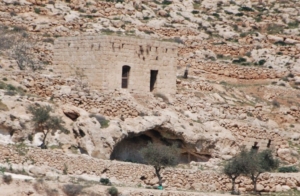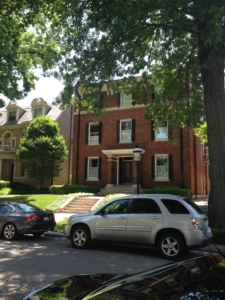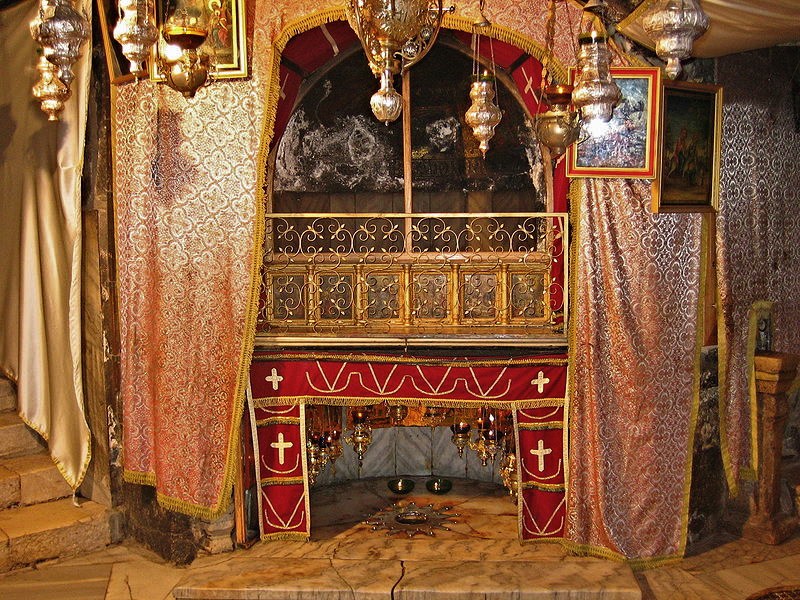To visit Bethlehem today is to visit a modern city torn struggling in the midst of the Palestinian-Israeli conflict. The famous wall between the territories runs right through the middle of modern Bethlehem.
Nevertheless, pilgrims still flock to the ancient Church of the Nativity the oldest Christian church still standing–built by the Emperor Constantine in the early fourth century. It was re-built and restored over the centuries, but in the lower level the pilgrim can still kneel and venerate the silver star that marks the place of the Savior’s birth and see the niche in the cave wall where he was laid.
But is this really the site of the birth of Jesus? Isn’t it just an ancient monument that marks the site of a legend or myth? Why this particular spot and not some other location in Bethlehem? The witness of the gospel is affirmed by the early Christian writings. Justin Martyr (100-165) –writing from the area of Samaria just North of Judea says Joseph found lodging for Mary in a cave outside the village, and that was where the Christ child was born. A little later Origen (185- 254) remarks that pilgrims of his time were going to visit the cave where Christ was born in Bethlehem. Therefore, from the second century we have documentary evidence that this place was already a site of pilgrimage. For this to be the case, the traditions about this site must pre-date Justin Martyr and Origen’s witness. 
Does this account match what we know of the culture of the time? There is an interesting extended article on the place of Jesus’ birth here but the short version is that in ancient Palestine many homes were built in and around caves. Often a few rooms would be added to the top or side of the cave and the animals would be kept in the cave-stable. Here’s a picture of one from near Bethlehem.
Therefore the early tradition of Jesus being born in a stable which was also a cave fits with the culture of the time.
But how do we know it was this cave? In the fifth century St Jerome came to Bethlehem to live in a cave immediately adjacent to the site of Jesus’ birth. You can visit his cell today in the crypt level of the Church of St Catherine which is right next to the Church of the Nativity. St Jerome records in 420 AD that the Emperor Hadrian in the year 135 AD had destroyed an earlier Christian site and built a temple to the god Adonis. Adonis, according to some scholars, was one of paganism’s “dying and rising gods” so one can see why the Emperor Hadrian may have wanted to supplant and replace the birthplace of the Christian god who rose from the dead. Be that as it may, the archeological evidence points to the fact that if Hadrian built a pagan site there it was because that site had already become a pilgrimage place for Christians who were honoring the birthplace of the Lord, and this connects with the documentary evidence from the same time period by Justin Martyr and Origen.
The evidence that Christians were worshipping at this site therefore dates from the beginning of the second century–at most one hundred and twenty years after the birth of Christ. Would the local people have retained a memory of the exact site? I think so. We only have to look around at the world today to see how the homes of famous people are remembered, identified, marked, and become places of p ilgrimage. What famous person was born a hundred and twenty years ago? C.S.Lewis for one. His Oxford home has been turned into a study center and pilgrimage site for visitors, and this article tells how his boyhood home in Belfast is visited by C.S.Lewis fans.
ilgrimage. What famous person was born a hundred and twenty years ago? C.S.Lewis for one. His Oxford home has been turned into a study center and pilgrimage site for visitors, and this article tells how his boyhood home in Belfast is visited by C.S.Lewis fans.
If it’s of any interest, T.S.Eliot was born ten years before C.S.Lewis. Here’s a picture of his boyhood home in St Louis. There’s a plaque on the pavement outside marking the spot.
I think we can trust the tradition based on the experience of the believers in Judea in the first century who lived locally.
It is this evidence-based tradition which convinced the Empress Helena (mother of Constantine) to begin construction of the Church of the Nativity in the year 327, and it is on that same site that Mass will be celebrated tonight in Bethlehem on Christmas Eve.







Leave A Comment
You must be logged in to post a comment.